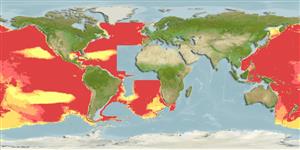>
Lophiiformes (Anglerfishes) >
Gigantactinidae (Whipnose anglers)
Etymology: Gigantactis: Greek, 'gigas' or 'gigantos' = gigantic + Greek, 'aktis' = ray (referring to the unusually long first dorsal-fin spine that functions as a lure in this genus) (Ref. 86949).
Eponymy: Dr Ernst Vanhöffen (1858–1918) was a German zoologist, geologist and botanist. [...] (Ref. 128868), visit book page.
Environment: milieu / climate zone / depth range / distribution range
Ecología
marino batipelágico; rango de profundidad 300 - 5300 m (Ref. 559), usually 700 - 1300 m (Ref. 117245). Deep-water; 68°N - 57°S, 180°W - 180°E
Tropical and temperate parts of all oceans. North-eastern Atlantic: single record at 62°39'N, 33°45'W. Absent from Mediterranean (Ref. 36125).
Tamaño / Peso / Age
Maturity: Lm ? range ? - ? cm
Max length : 62.0 cm TL (female)
Short description
Claves de identificación | Morfología | Morfometría
Espinas dorsales (total) : 0; Radios blandos dorsales (total) : 6 - 7; Espinas anales: 0; Radios blandos anales: 6. Esca covered with minute spines and bearing distally-flattened papillae; elongate, darkly pigmented distal prolongation attached to escal bulb; short, black filaments concentrated around tip of the prolongation; escal bulb with 2-3 unpigmented filaments; close-set pair of small appendages on posterior margin of illicium some distance below bulb (Ref. 13608); length of illicium less than 120% SL (71-112% SL in specimens greater than 25 mm); relatively long dentary teeth (longest 2.6-5.0% SL) in three longitudinal series; length of rays of caudal fin less than 45% SL (Ref. 86949).
Rarely caught (Ref. 559).
Life cycle and mating behavior
Madurez | Reproducción | Puesta | Huevos | Fecundidad | Larva
Bertelsen, E., 1990. Gigantactinidae. p. 513-515. In J. C. Quero, J. C. Hureau, C. Karrer, A. Post and L. Saldanha (eds.) Check-list of the fishes of the eastern tropical Atlantic (CLOFETA). JNICT, Lisbon; SEI, Paris; and UNESCO, Paris. Vol. 1. (Ref. 10761)
IUCN Red List Status (Ref. 130435: Version 2024-1)
Threat to humans
Harmless
Human uses
Pesquerías: sin interés
Herramientas
Special reports
Download XML
Fuentes de Internet
Estimates based on models
Preferred temperature (Ref.
123201): 1.9 - 4.7, mean 3.1 °C (based on 4024 cells).
Phylogenetic diversity index (Ref.
82804): PD
50 = 0.5000 [Uniqueness, from 0.5 = low to 2.0 = high].
Bayesian length-weight: a=0.01995 (0.00906 - 0.04395), b=3.01 (2.83 - 3.19), in cm total length, based on all LWR estimates for this body shape (Ref.
93245).
Nivel trófico (Ref.
69278): 4.5 ±0.8 se; based on size and trophs of closest relatives
Fishing Vulnerability (Ref.
59153): Moderate vulnerability (45 of 100).
